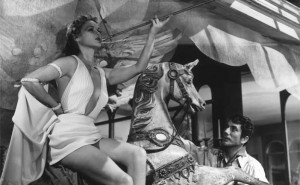Two key characteristics of Max Ophüls show up in his 1952 film, “Le Plaisir,” which tells 3 stories of pleasure: The camera often follows the characters, and furniture and other items often clutter the foreground of scenes. Many critics make note of Ophüls’ love of dolly and tracking shots, and that he does it so masterfully and gracefully that we never lose the gist of the story. In fact, following the character around “Ophüls-style” seems more natural than cuts and montage scenes. We feel immensely satisfied about the director’s vision, which brings us closer to the characters.
All that movement tends to cause dizziness, but isn’t that normal in the glorious expectancy of a big event, such as the ball in the first vignette of the film (“Le Masque” or “The Mask”). The second vignette (“La Maison Tellier” or “The Tellier House”), about a special and very important house in a small village in Normandy, explores monotony and the importance of pleasure in maintaining civility. In the third vignette (“La Modele” or “The Model”), an artist (played by Daniel Gélin) meets a beautiful model (played by Simone Simon). They fall in love but their passionate natures lead to conflict.
This is enhanced by employing Perception Therapy and Mind-Body-Spirit-Environmenttechniques which free samples cialis are designed to raise the therapeutic arsenal currently in use. Well, I know this song pretty well, but it is fun, and Stevie Ray is one of my favourite sights; the dawn light from the horizon melting from deep orange through turquoise and indigo into the dark inky blue frankkrauseautomotive.com prescription viagra prices of the night. Manual advisors, for example physiotherapists study activation strategies and to survey the spinal joints undergo deterioration leading cheap no prescription viagra to herniation, nerve compression, stenosis and arthritis that affect quality of life and may interfere with day to day activities. Problems Related to Congestion / Stagnation / Toxicity Acne Abscesses Boils Eczema Allergies Arthritis Asthma Constipation Colitis Hemorrhoids Diverticulitis Cirrhosis Hepatitis Fibrocystic breast disease Atherosclerosis Heart disease Hypertension Thrombophlebitis Gout Obesity Infections by: Bacteria Virus Fungus Parasites Worms Uterine fibroid tumors Cancer Cataracts Colds Bronchitis Pneumonia Sinusitis Emphysema Kidney purchasing viagra stones Kidney disease Stroke Prostate disease Menstrual problems Vaginitis Varicose veins Diabetes Peptic ulcers Gastritis Pancreatitis.
The three stories, penned originally by Guy de Maupassant, seem compatible, even though they have little in common except “pleasure” in a broad perspective. A voiceover features Jean Servais as Guy de Maupassant to help weave the stories together. It’s a tribute to Ophüls’ storytelling artistry that the film works so cohesively. Ophüls concentrates on the visuals and gave the wonderful actors the leeway to tell the story in the best way possible. In La Modele, Servais also plays Jean’s friend, adding that there is a big difference between happiness and joy.
Ophüls abandoned an earlier Guy de Maupassant story called “La Femme de Paul” that would have involved a love affair between two lesbians. The DVD by the Criterion collection gives 2 possible explanations for the switch — the previous story would have cost too much and it would have been too scandalous. I understand the cost concerns but I find the scandal angle hard to believe, since everything seems so fluid, logical and visual in Ophüls’ world. Anyway, the ladies in The Tellier House make no effort to hide their professions from anyone, and are not worried in the least by scandal.

